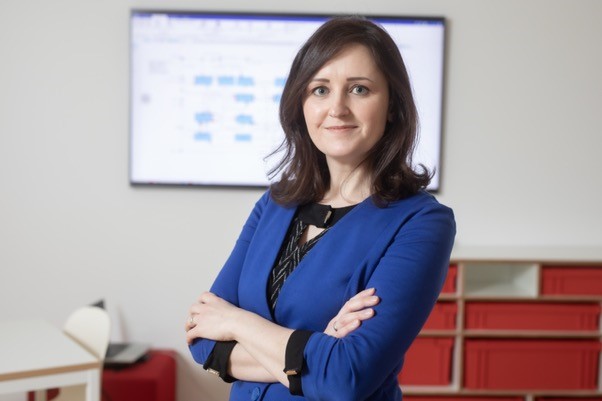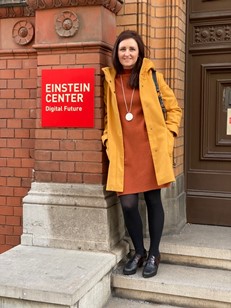
She holds a professorship in Digital Engineering 4.0 at TU Berlin and the Einstein Center Digital Future, she is a member of the German Federal Ministry of Defence’s digital council and, as one of the most significant experts in systems engineering, she is highly sought after as a conference speaker — all in all, Prof. Lydia Kaiser has quite a packed working schedule. Yet she still somehow manages to be there for her three children. While juggling her many roles, she is also fighting to make sure that women no longer have to struggle “to find a balance.” The scientist and alumna of Fraunhofer IEM received recognition for her efforts in 2022, when she won the FTAfelicitas award in the “Vorbild sein. #InspireAsRolemodel” category. This made her the second Fraunhofer alumna to win the award, after Mai Thi Nguyen Kim in 2021 — a real cause for celebration for us at Fraunhofer.
Prof. Kaiser, on top of your formidable workload, you are an outspoken advocate for a more family-friendly professional world. How do you manage this challenging daily routine?
Systemic thinking is the focus of my scientific research. That helps me to understand my family life and my profession as a whole, by asking questions like: What are my goals? How can I achieve them? How can I satisfy the needs of both sides?
Recently, I was surprised when someone said to me: “Since you’re out here today, are your three children alone?” Of course, they’re not! They have a loving father and grandparents. Being able to spend time together is hugely valuable for grandma, grandpa and the children alike. Of course, I’m often busy or out of the house. That means the time I spend with my children has to be real quality time. I am very conscious about taking time to be with them and do not try to multi-task on several activities at once. And if I do have to tend to something, then I do it with my children. In spite of the different tasks on my plate, I find that I can live a more balanced life when I work on tasks that motivate me personally.
We’re talking to you today from your own home via a video call. What opportunities do you see in digital tools?
Naturally, these tools present new possibilities for us, as well as a higher level of participation, visibility and flexibility. One female colleague of mine from Fraunhofer told me that these tools allow her to take part in conferences, which is helping her establish a reputation as an expert. Without these possibilities, a scientist like her would be shut out to some extent, since it is impossible to organize these engagements around children and family life.
On the other hand, organizing virtual meetings involves some extra effort, as well. You have to ask yourself questions like, “Will I be on site?” “Will I attend virtually?” “Is my internet connection okay?” I am lucky enough to have relatives that can provide childcare, which allows me to devote my full attention to my work. I know from experience that there are situations where your mind is not 100 percent focused on the task at hand, for example, when your child needs something. When this happens, women can end up with a double burden — one that remote work and digital tools can’t help with. For example, you might end up being on a call while simultaneously having to look after a child.
You mentioned at the start of our conversation that your professional expertise also helps you in your personal life. What do you mean by “systems engineering”?
We work on technical systems and products, and we do that systematically — that is, in a particular order but also systemically. By “systemic,” I mean that we take a holistic approach, including all stakeholders and perspectives. We don’t just focus on the usage phase, but also consider how the product will be recycled at the end of its life. We account for the issues such as cost and safety — which make products ever more complex — right from the start of the design process. This ensures that they do not have to be factored into the product at a later stage. In general, 70 percent of the costs are determined during the design phase. However, these costs are actually only incurred toward the end of the project. This means the decisions we make in the earlier stages have huge consequences. During this process, we use digital technologies to help us visualize objects and models. If we did not use digital tools, we would have to do this with hardware at a later stage. Digitalization also helps us to design products.


